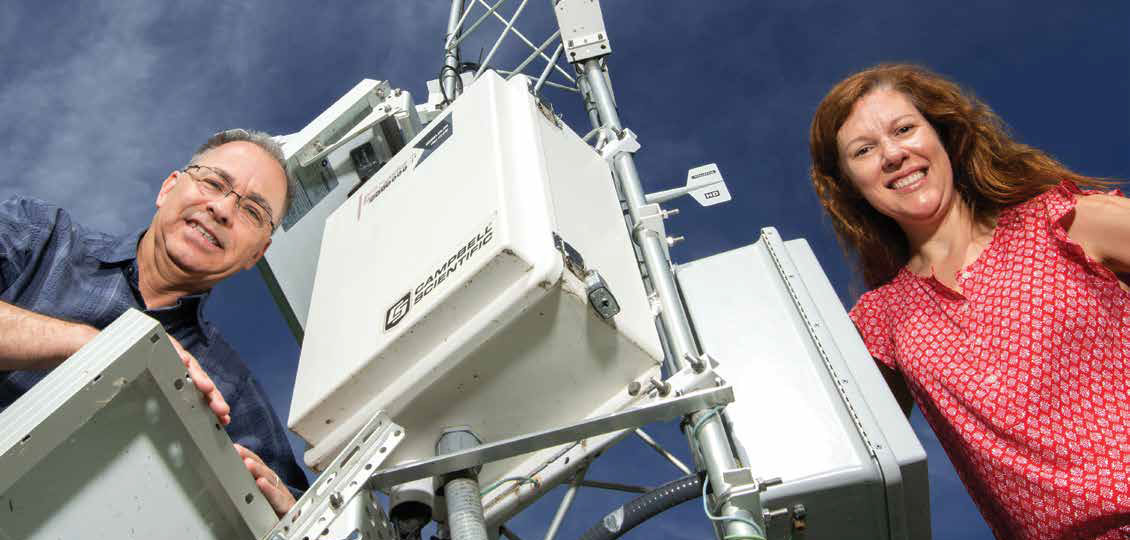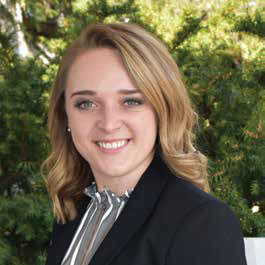
Researching in a Climate Crossroads
Nebraska’s Climate Research Informs National Climate Assessment

Weather varies around the world and researchers often travel hundreds of miles to study different climates. The state of Nebraska is described as a researcher’s gold mine, as Nebraska sits at a climate crossroads, according to Martha Shulski, Nebraska State Climatologist, director of the Nebraska State Climate Office and associate professor, and Michael Hayes, drought specialist, climatologist and professor in the School of Natural Resources at the University of Nebraska–Lincoln.
“Nebraska lies at an intersection — a crossroads of climate — where it is relatively wet in the east and relatively dry in the west, and there is a gradient that ranges from colder to warmer from north to south across the state. We get such variable climate that it is a really interesting place to study,” Shulski said. Multiple research centers exist in Nebraska and these centers allow scientists to study climate variability all in one place. This research is then shared around the globe.
For example, Shulski and Hayes had the opportunity to share research conducted in Nebraska in the Fourth National Climate Assessment, published in 2018. Specifically, Shulski and Hayes partnered with eight other individuals to work on chapter 22 of the assessment. The Northern Great Plains chapter focused on Nebraska, Montana, North Dakota, South Dakota and Wyoming.
According to Shulski, the National Climate Assessment is a mandatory report submitted to the U.S. Congress every four years, as stated in the United States Global Change Research Act of 1990. This assessment is available to the public at https://nca2018.globalchange.gov/ and can be used as an educational tool to make more informed decisions about climate.
“That's really what the National Climate Assessment is all about — bringing science to the user and making it understandable to people. And that’s been a really exciting part about being involved with it,” Shulski said.
Both Hayes and Shulski use components of the assessment in their work. For example, Hayes said he uses the assessment in his own classes as data references and learning aids and hopes that high schools begin to incorporate the assessment into their curriculum as well. In March 2019, Shulski used the assessment to inform the first Nebraska Climate Summit hosted at the university with the goal of bringing locals into the climate conversation.
What is Climate?
Shulski described climate as the averages and variations of weather gathered over a long-term period of time. According to Shulski, knowing the difference between weather and climate is key when explaining how climate changes over time.
Shulski shared the example she typically uses when teaching about climate. “Weather is what I'm wearing today and climate is the clothes in my closet,” Shulski said. “Climate is the whole spectrum of weather that we can experience. Climate describes the average conditions that you would expect to experience.” Research on climate change focuses on climate trends, not daily weather patterns, according to Shulski.
The university takes advantage of the variable weather across the state in the best way possible, according to Hayes. He said that the university has a great setting for research given the variability and the availability of unique facilities.
Research facilities located at the university include the High Plains Regional Climate Center; the National Drought Mitigation Center; the Daugherty Water for Food Global Institute; the Center for Advanced Land Management Information Technologies; and the State Climate Office, which includes the operations of the Nebraska Mesonet, a statewide weather observation network with nearly 70 locations across Nebraska that assess local conditions. Together, these resources make Nebraska a leader in climate research and a great opportunity for undergraduate and graduate student education, according to Hayes.
“I think it's really unique here at Nebraska that we have a suite of centers that exist,” Hayes said. Scientists in these research facilities disseminate a wide variety of climate information products from the data that are collected.
Insert graphic/photo of research facilities at the university.
Spreading Climate Awareness
Shulski and Hayes mentioned the importance of spreading awareness and starting conversations on the topic of climate. However, they say they sometimes face challenges when communicating research findings to the public. Both said that communicating a message in a scientific way is most successful — especially when conversing with those who are unconcerned about the climate change topic.
“One question I've been asked when giving presentations is ‘you don't believe in all this, do you?’ And I usually say, well, it doesn't necessarily matter what I believe. We are looking at the science and we are looking at data and analyzing that. It is not a personal belief system. It is data,” Shulski said.
Shulski explained that it is important to listen to the public to understand what matters to them. From there, the conversation can connect what they think is important or interesting to the change that is happening to climate.
Changing the Future
Shulski and Hayes said it is important to find common ground when making goals about what individuals can do to slow down the climate change that is occurring. Individuals can first consider their own carbon footprint.
“We can't manage what we don't measure. Everyone can start to measure his or her own impact on the environment,” Shulski said.
Every person can start evaluating his or her own carbon footprint by using weather and climate research as a tool to learn about impacts and adaptations of climate. Shulski and Hayes suggested that people be aware that change is happening and assess personal use. To lower one’s carbon footprint, individuals might consider:
- Consciously driving fewer miles
- Purchasing food grown locally instead of food that must be transported many miles
- Purchasing clothing sold locally to reduce environmental costs of transportation
- Considering the carbon costs of food consumed or other goods purchased
- Voting for candidates who support policies beneficial to the environment
- Reducing the amount of work-related travel
“We have the brain power to fix this and define solutions. We just need the willpower to do it,” Shulski said.
Shulski uses social media as an outlet to educate the public. Using the Twitter handle @mshulski3 and the Nebraska State Climate Office Facebook page, Shulski frequently posts information with statistics, models and facts that are quick reads for the public.
Shulski and Hayes, among others, work hard to make information available to the public. From this research, the public can then make well-informed decisions.